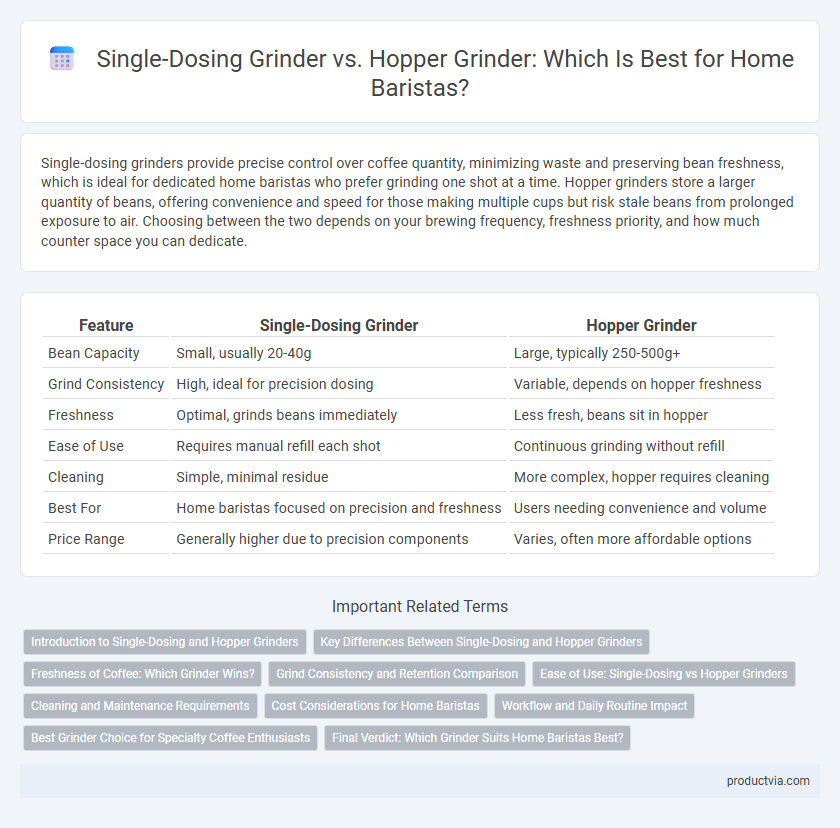Single-dosing grinders provide precise control over coffee quantity, minimizing waste and preserving bean freshness, which is ideal for dedicated home baristas who prefer grinding one shot at a time. Hopper grinders store a larger quantity of beans, offering convenience and speed for those making multiple cups but risk stale beans from prolonged exposure to air. Choosing between the two depends on your brewing frequency, freshness priority, and how much counter space you can dedicate.
Table of Comparison
| Feature | Single-Dosing Grinder | Hopper Grinder |
|---|---|---|
| Bean Capacity | Small, usually 20-40g | Large, typically 250-500g+ |
| Grind Consistency | High, ideal for precision dosing | Variable, depends on hopper freshness |
| Freshness | Optimal, grinds beans immediately | Less fresh, beans sit in hopper |
| Ease of Use | Requires manual refill each shot | Continuous grinding without refill |
| Cleaning | Simple, minimal residue | More complex, hopper requires cleaning |
| Best For | Home baristas focused on precision and freshness | Users needing convenience and volume |
| Price Range | Generally higher due to precision components | Varies, often more affordable options |
Introduction to Single-Dosing and Hopper Grinders
Single-dosing grinders grind coffee beans one dose at a time, eliminating the need for a hopper and reducing stale coffee buildup, making them ideal for precise, fresh brewing. Hopper grinders store larger quantities of beans in a container, offering convenience for frequent use but may expose beans to air and light, affecting freshness over time. For home baristas seeking ultimate control and bean freshness, single-dosing grinders provide superior precision, while hopper grinders suit those prioritizing ease and speed in everyday coffee preparation.
Key Differences Between Single-Dosing and Hopper Grinders
Single-dosing grinders require users to measure and grind coffee beans for each shot individually, ensuring maximum freshness and minimal retention, ideal for home baristas prioritizing flavor precision. Hopper grinders store larger quantities of beans in a container, offering convenience and faster grinding for multiple servings but with potential exposure to stale beans and increased retention. Key differences include freshness control, grind consistency, ease of use, and maintenance demands specific to single-dose versus hopper-capacity designs.
Freshness of Coffee: Which Grinder Wins?
A single-dosing grinder preserves coffee freshness by grinding only the exact amount needed, eliminating exposure to air that causes staling, unlike hopper grinders which store beans and expose them repeatedly to oxygen. Freshness is critical for maximizing flavor and aroma, making single-dosing grinders the ideal choice for home baristas who prioritize peak coffee quality. Hopper grinders offer convenience for larger volumes but can compromise freshness due to repeated bean exposure.
Grind Consistency and Retention Comparison
Single-dosing grinders offer superior grind consistency by allowing precise measurement of each dose, minimizing stale coffee retention and ensuring fresh bursts per brew. Hopper grinders, while convenient for larger quantities, tend to retain old grounds in the chute and burrs, compromising flavor clarity and uniform particle size distribution. For home baristas prioritizing flavor precision and minimal retention, single-dosing grinders provide a more consistent and fresher grind experience.
Ease of Use: Single-Dosing vs Hopper Grinders
Single-dosing grinders offer precise control over coffee quantity, minimizing bean exposure and ensuring maximum freshness for each brew. Hopper grinders provide convenience with larger bean capacity, reducing the need for frequent refills but may compromise freshness over time. For home baristas valuing ease of use and freshness, single-dosing grinders streamline the process through measured dosing without guesswork.
Cleaning and Maintenance Requirements
Single-dosing grinders require minimal cleaning due to their compact design and absence of a large bean hopper, reducing stale coffee buildup and residue. Hopper grinders collect more coffee grounds and oils, necessitating more frequent and thorough cleaning to prevent flavor contamination. Regular maintenance for single-dosing models is simpler and quicker, making them ideal for home baristas prioritizing cleanliness and convenience.
Cost Considerations for Home Baristas
Single-dosing grinders typically offer a more affordable upfront cost compared to hopper grinders, making them ideal for budget-conscious home baristas who prioritize precision and freshness over volume. Hopper grinders generally involve higher initial investment but provide larger bean capacity, reducing the need for frequent refills in busy home setups. Evaluating long-term value, single-dosing models minimize waste and maintain consistent grind quality, while hopper grinders cater to convenience at a potentially higher operational cost.
Workflow and Daily Routine Impact
Single-dosing grinders streamline workflow by eliminating bean storage, allowing home baristas to grind precise amounts for each shot, reducing waste and maintenance time. Hopper grinders enhance convenience with larger bean capacity, supporting continuous brewing but may require more frequent cleaning and can compromise bean freshness over time. Choosing between them impacts daily routine efficiency, balancing freshness, ease of use, and consistency in coffee preparation.
Best Grinder Choice for Specialty Coffee Enthusiasts
Single-dosing grinders offer precise control over coffee quantity, ensuring freshness and reduced waste by grinding only what's needed for each brew, ideal for specialty coffee enthusiasts who value flavor clarity. Hopper grinders provide convenience and speed, holding larger quantities of beans for multiple brews, making them suitable for high-volume or shared home barista setups. For the best grinder choice, single-dosing grinders excel in maintaining bean integrity and grind consistency, crucial for achieving optimal extraction in specialty coffee.
Final Verdict: Which Grinder Suits Home Baristas Best?
Single-dosing grinders provide precise, freshly ground coffee with minimal waste, ideal for home baristas who prioritize quality and variety in their brews. Hopper grinders offer convenience and larger capacity, suiting those who prepare multiple cups consistently without frequent refilling. For home baristas seeking ultimate control and freshness, single-dosing grinders are the preferred choice, while hopper grinders serve best for efficiency and volume.
Single-dosing grinder vs Hopper grinder for home barista Infographic

 productvia.com
productvia.com